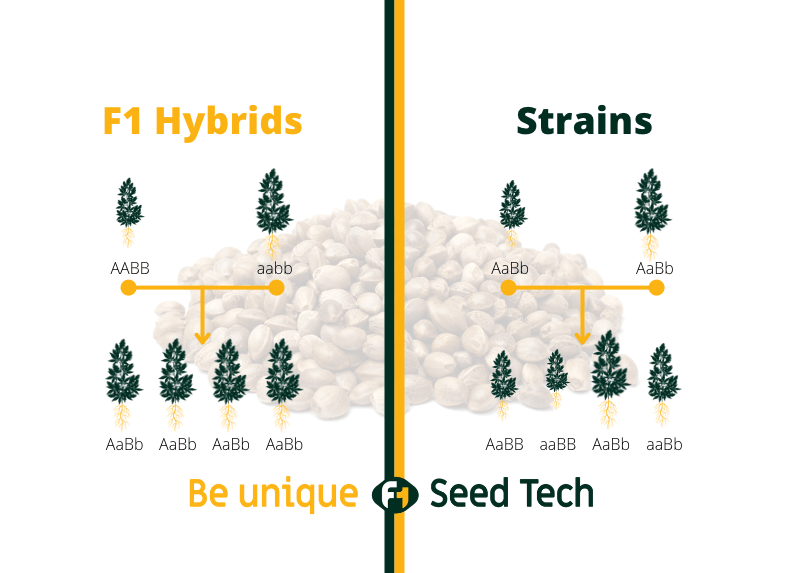The vast majority of cannabis seeds available are marketed as hybrids. But not all hybrids are the same. Most of the cannabis seeds available at seed banks and dispensaries are called strains, meaning they are the progeny of two non-fixed parents. While many of them offer good results, they lack the uniformity and productivity of true F1 hybrids. These varieties are new to the cannabis industry, and they’re poised to become the mainstay among both home growers and commercial cultivators in the coming years.
F1 Hybrids & Strains: What’s The Difference?
Breeding techniques are the main difference between F1 hybrids and strains. Breeding F1 hybrids requires 3 – 4 years of professional breeding, a scientific team, and an appropriate breeding method. Whereas breeding strains can be done by many home growers who find success in crossing their own strains. Discover the main genetic differences between these two seed types below.
F1 Hybrids
F1 hybrids are created when breeders selectively cross parent plants from two inbred lines under highly controlled conditions. The abbreviation “F1” stands for “filial 1” and denotes the first generation following a cross.
After developing two solid inbred lines that are fixed on certain characteristics, breeders then cross one parent from each line. Pairing two genetically distinct cultivars reverts inbreeding depression and leads to a phenomenon known as heterosis in the F1 hybrid progeny.
The progeny display hybrid vigour—an increase in health, yield, resistance, and secondary metabolite production. The offspring will also display high uniformity, making F1 hybrids extremely commercially valuable and a more efficient alternative option to cloning.
Strains
Strains occur when a cannabis breeder crosses two non-fixed strains. Often, the parent used descend from landraces with relatively low genetic variability. Therefore, the parents feature a mix of traits from both landraces. Crossing two strains results in heterogeneous progeny with relatively unstable genetics.
Most strains available produce populations with varying traits, from size to yield. To refine these genetics, breeders must continue to develop F2, F3, F4 generations, and so on, until they develop populations with less phenotypic variation.
F1 Hybrids vs Strains: Performance Differences
Now that you’re aware of the basic differences between an F1 hybrid and strain seeds, we’re going to look at their key differences in breeding techniques, yield, disease resistance, and availability.
Yield
How do F1 hybrids perform against strains when it comes to yield?
- Strains: Refined strains often produce good yields. However, genetic variation between specimens means some may perform much better than others.
- F1 hybrids: F1 hybrids produce better yields for two reasons. First, some F1 hybrids descend from two inbred lines specifically selected for high productivity. Second, the phenomenon of hybrid vigour will increase yields in F1 progeny, even in cultivars not specifically bred for productivity.
Disease Resistance
Do F1 hybrids have an edge when it comes to defending against pathogens?
- Strains: Disease resistance varies greatly between strains. Whereas some strains are better genetically equipped to deal with certain diseases, others are more susceptible. Resistance also varies between different phenotypes within the same progeny.
- F1 hybrids: F1 hybrids boast a stronger resistance to disease out of both seed types. Hybrid vigour gives F1 specimens an upper hand, and some F1 hybrids descend from inbred lines can be designed with fixed resistances to fend off disease in commercial settings.
Uniformity
Why seed type scores highest when it comes to uniformity?
- Strains: strains often display an array of phenotypes. Not only do the progeny differ in size, but also in productivity, resilience, and secondary metabolite production.
- F1 hybrids: These genetics are a proven technology in the world of agriculture. F1 hybrids provide high uniformity between progeny.
Which Seed Type Is Superior for Commercial Growing?
F1 hybrid seeds are the mainstay of modern agriculture. Every time you step into a supermarket, you’ll notice striking uniformity between each type of tomato, pepper, and corn. These are all from F1 plants. Not only they are more efficient, but the farmers that grew them dealt with fewer pests and diseases and profited from higher yields. Innovative companies have only just made F1 hybrids a reality in the cannabis world. However, you can expect both large-scale commercial operations and home growers to rapidly adopt these seeds given their numerous benefits.
Are you interested in learning more about F1 hybrid cannabis seeds? Check out our Press section for everything you need to know. Alternatively, speak to our team about F1 hybrid seeds by sending an email to info@f1seedtech.com

